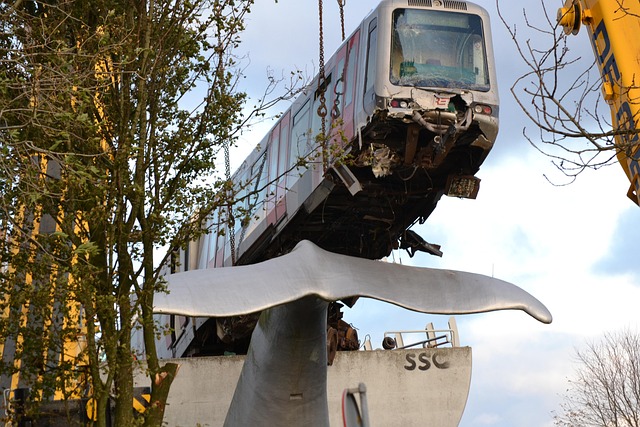Head-On Collision Injuries: Understanding and Navigating Legal Recourse

Head-on collisions, due to their direct impact and high force, often result in severe car accident i…….
Car accident injuries encompass a wide range of physical, emotional, and economic consequences that arise from motor vehicle collisions. This complex and multifaceted issue impacts individuals, communities, and societies at large, shaping public health, safety, and economic landscapes. In this article, we embark on an in-depth exploration of car accident injuries, delving into their causes, impact, global reach, technological innovations, policy responses, and future prospects. By the end, readers will have a comprehensive understanding of this critical topic and its far-reaching implications.
Car accident injuries refer to the physical, mental, and economic harm suffered by individuals involved in motor vehicle crashes. These injuries can range from minor bruises and cuts to severe traumas, including head injuries, spinal cord damage, and internal organ injuries. Beyond the immediate physical effects, car accidents also have profound emotional and psychological consequences, affecting victims’ mental health and overall quality of life.
The core components of car accident injuries include:
Physical Injuries: These range from soft tissue injuries (e.g., whiplash) to more severe fractures, internal bleeding, and organ damage. The severity and type of physical injuries often depend on the speed of impact, the angle of collision, and the safety features of the vehicles involved.
Emotional and Psychological Trauma: Car accidents can lead to various psychological disorders, including post-traumatic stress disorder (PTSD), anxiety, depression, and traumatic brain injuries (TBI). The emotional distress can affect victims’ ability to drive, work, and engage in daily activities.
Economic Costs: Beyond medical expenses, car accident injuries impose significant economic burdens, encompassing lost wages, reduced earning potential, disability benefits, and legal fees. These costs can have long-term financial implications for individuals and societies.
Historically, the awareness and understanding of car accident injuries have evolved significantly. Early responses focused primarily on physical treatment, while modern approaches emphasize a holistic view that incorporates psychological support and rehabilitation. This shift reflects a growing recognition of the complex interplay between physical and mental health in injury recovery.
Car accident injuries are a universal concern, impacting individuals across all continents. However, their severity and prevalence vary widely due to regional factors such as infrastructure, traffic laws, vehicle safety standards, and cultural attitudes towards road safety.
Rising Motorization: In many developing countries, the increase in motor vehicles on the road has led to a corresponding rise in traffic accidents and related injuries. This trend underscores the need for robust infrastructure and safety measures to accommodate growing vehicular traffic.
Urbanization and Congestion: Urban areas, with their dense populations and complex traffic patterns, often experience higher rates of car accidents and more severe injuries. Addressing urban mobility challenges is crucial in mitigating these trends.
Aging Population: As societies age, the number of elderly drivers on the road increases, raising concerns about their vulnerability to car accidents due to reduced reflexes and cognitive abilities. This trend requires tailored safety interventions and support systems.
Improved Survival Rates: Advances in medical technology and emergency response systems have led to better survival rates for severely injured crash victims, although the subsequent rehabilitation needs can be extensive.
North America and Europe: These regions generally have well-developed road safety regulations and advanced healthcare systems, resulting in relatively lower injury rates compared to other parts of the world. However, they still face challenges related to distracted driving and speeding.
Asia Pacific: Rapid industrialization and urbanization have led to a surge in motor vehicle ownership, contributing to rising traffic accident numbers. Countries like China and India are working on improving road safety infrastructure and education.
Africa and Middle East: These regions often struggle with inadequate road safety standards, poor infrastructure, and limited access to quality healthcare, leading to higher injury and mortality rates from car accidents.
The economic implications of car accident injuries are far-reaching and multifaceted. These incidents not only affect individuals but also have significant impacts on healthcare systems, insurance companies, employers, and governments.
Healthcare Costs: Medical treatment for car accident injuries represents a substantial portion of healthcare expenditure in many countries. Advanced technologies and specialized care for complex injuries drive up these costs.
Insurance Claims: Motor vehicle accidents result in a surge in insurance claims, impacting both personal auto insurance and commercial insurance markets. Insurers often adjust premiums based on individual risk profiles and regional accident rates.
Productivity Loss: Injuries leading to missed workdays or long-term disabilities contribute to productivity losses for individuals and employers. This impact is particularly pronounced in industries requiring physically demanding labor.
Healthcare Infrastructure: Governments and private investors often allocate substantial funds to improve healthcare facilities, emergency response systems, and rehabilitation centers to better manage the influx of accident victims.
Road Safety Initiatives: Investments in road safety infrastructure, such as traffic lights, speed bumps, and improved signage, aim to reduce accident rates and mitigate injuries.
Technology Research: The pursuit of innovative solutions, including autonomous vehicles and advanced driver-assistance systems (ADAS), attracts significant investment to address the challenges posed by car accidents.
Technological innovations play a pivotal role in shaping the landscape of car accident injuries, offering both immediate solutions for injury prevention and long-term potential for transforming road safety.
Advanced Driver Assistance Systems (ADAS): Features like adaptive cruise control, automatic emergency braking, lane departure warning, and blind-spot monitoring help prevent accidents by alerting drivers to potential hazards. These systems have shown promising results in reducing collision rates.
Vehicle Safety Features: Improvements in crumple zones, airbags, seatbelt technology, and energy-absorbing materials continue to enhance passenger protection during collisions.
Telematics and Data Analytics: The use of telematics devices and data analytics enables real-time monitoring of driver behavior, helping insurance companies offer personalized coverage and safety recommendations.
Autonomous Vehicles: Self-driving cars have the potential to revolutionize road safety by significantly reducing human error, which is a leading cause of accidents. However, challenges related to regulatory frameworks and public acceptance need to be addressed.
Wearable Technology: Devices that monitor vital signs and track driver behavior can provide early warnings for health issues or fatigue, enhancing overall road safety.
Connected Cars: Vehicle-to-vehicle (V2V) and vehicle-to-infrastructure (V2I) communication technologies enable real-time sharing of data, improving traffic flow and accident prevention.
Effective policies and regulations are essential for managing car accident injuries and fostering a safer driving environment. Governments worldwide have implemented various measures to address this complex issue.
Traffic Laws and Speed Limits: Enforcing strict traffic laws, including speed limits, alcohol restrictions, and seatbelt laws, remains a cornerstone of road safety policies. Regular amendments and enforcement campaigns help keep these regulations relevant and effective.
Vehicle Safety Standards: Governments mandate minimum safety standards for vehicles, covering aspects like structural integrity, braking systems, and airbags. These standards ensure that new vehicles on the road meet certain safety thresholds.
Road Infrastructure Development: Investing in well-designed roads, signage, lighting, and traffic management systems is crucial for accident prevention. Safe infrastructure saves lives and reduces the severity of injuries.
Insurance Mandates: Compulsory insurance laws require drivers to have financial protection against the costs associated with accidents. This ensures that victims receive compensation for their injuries and losses.
Several international organizations play a vital role in harmonizing safety standards and fostering collaboration among nations:
World Health Organization (WHO): The WHO leads global efforts to improve road safety, providing guidelines, research, and technical assistance to member states.
United Nations (UN) and its sub-organizations: The UN’s Global Status Report on Road Safety offers a comprehensive overview of road accident trends and policy recommendations. Its Regional Offices also contribute to regional road safety initiatives.
Despite significant progress in addressing car accident injuries, several challenges and criticisms persist, demanding continued attention and innovative solutions.
Distracted Driving: The rise of mobile devices and in-vehicle entertainment systems has led to a growing problem of distracted driving, significantly increasing the risk of accidents. Addressing this issue requires public education campaigns and stringent enforcement of laws prohibiting the use of electronic devices while driving.
Inequitable Access to Healthcare: In many regions, individuals living in rural or underserved areas face challenges in accessing quality healthcare services after a car accident due to limited resources and transportation options. Expanding healthcare accessibility is crucial for effective injury management.
Insufficient Data Collection: Accurate data on traffic accidents and their outcomes remains fragmented across regions, hindering evidence-based policy formulation and resource allocation. Standardized data collection methods are essential for informed decision-making.
Public Awareness Campaigns: Educating the public about safe driving practices, vehicle maintenance, and the potential consequences of negligent behavior can lead to behavioral changes that reduce accident rates.
Strengthening Enforcement: Governments should allocate adequate resources to enforce traffic laws, particularly those related to speeding, alcohol consumption, and distracted driving. This includes increasing police presence on the roads and utilizing advanced surveillance technologies.
Promoting Alternative Transport: Encouraging the use of public transportation, cycling, and walking can help reduce the number of vehicles on the road, thereby decreasing accident risks.
Real-world implementations of strategies to address car accident injuries offer valuable insights and serve as models for other regions or countries.
Sweden’s Vision Zero program is a renowned example of a comprehensive approach to road safety. This initiative aims to eliminate all fatalities and serious injuries from roads by focusing on system-wide changes rather than individual penalties. Key elements include:
Safer Road Design: Swedish engineers redesign roads to reduce speed limits, create buffer zones, and implement other physical measures to prevent accidents.
Advanced Safety Features: The country encourages the adoption of safety technologies like collision avoidance systems and electronic stability control.
Public Education: Sweden conducts extensive public awareness campaigns, emphasizing shared responsibility for road safety among drivers, pedestrians, and cyclists.
As a result of these efforts, Sweden has achieved remarkable success in reducing traffic fatalities and serious injuries, setting a global benchmark for road safety.
Japan’s commitment to road safety is evident through its multi-faceted approach, which includes:
Stricter Traffic Laws: Japan enforces some of the world’s toughest traffic laws, with severe penalties for violations like speeding and running red lights.
Community Engagement: Local communities actively participate in road safety initiatives, organizing events to promote safe driving practices and raising awareness among residents.
Technological Interventions: The country has embraced advanced driver assistance systems (ADAS) and implemented intelligent transport systems (ITS) to optimize traffic flow and reduce accidents.
Japan’s strategies have led to a significant decrease in traffic fatalities, demonstrating the effectiveness of a combination of strict regulations, public engagement, and technological advancements.
Looking ahead, the landscape of car accident injuries is poised for transformative changes, driven by technological innovations, shifting societal attitudes, and evolving policy frameworks.
Autonomous Vehicles: As autonomous driving technology matures, self-driving cars could significantly reduce traffic accidents caused by human error. This shift will require robust regulatory frameworks to ensure safety and address new challenges.
Digital Health Integration: The integration of digital health technologies, such as wearable devices and telemedicine, offers opportunities for proactive injury prevention and enhanced rehabilitation services, especially in remote areas.
Data-Driven Policy Making: Advanced data analytics can provide valuable insights into accident patterns, enabling more precise targeting of safety interventions and resource allocation.
Shared Mobility and Electric Vehicles: The rise of ride-sharing services and electric vehicles (EVs) presents both opportunities and challenges for road safety. Balancing the benefits of these emerging mobility options with safety considerations will be crucial.
Cybersecurity in Vehicles: As connected cars become more prevalent, ensuring cybersecurity in vehicle systems is essential to prevent potential hacking that could compromise safety features.
International Collaboration: Addressing global road safety challenges requires continued international cooperation and knowledge sharing among countries with varying experiences and success stories.
Incorporating Mental Health: Policy makers should recognize the vital role of mental health in injury recovery and ensure that healthcare systems provide comprehensive support for victims’ psychological well-being.
Sustainable Transportation Planning: Cities need to adopt sustainable transportation planning that promotes multi-modal transport options, reduces traffic congestion, and creates safer environments for all road users.
Car accident injuries represent a complex and multifaceted challenge that demands comprehensive solutions. By understanding the historical context, global trends, economic implications, technological advancements, and policy responses, we can navigate this issue more effectively.
The articles highlights the importance of a holistic approach to managing car accident injuries, encompassing not just physical treatment but also psychological support, rehabilitation, and preventive measures. As technology continues to evolve, policies must adapt to new realities, such as autonomous vehicles and shared mobility.
Ultimately, fostering safer roads and mitigating the impact of car accidents require sustained efforts from governments, healthcare providers, law enforcement agencies, insurance companies, and individuals alike. By learning from successful case studies and embracing emerging trends, we can work towards a future where car accident injuries are significantly reduced, and road safety becomes a shared priority globally.
Q: What are the most common causes of car accidents?
A: While causes vary, distracted driving (e.g., using mobile phones), speeding, alcohol or drug impairment, fatigue, and poor weather conditions are among the leading causes of car accidents worldwide.
Q: How do I know if I have a valid claim for car accident injuries?
A: Evaluating a claim involves assessing the severity of your injuries, understanding local laws, and reviewing the circumstances surrounding the accident. Consulting with an experienced legal professional or insurance adjuster can provide guidance tailored to your situation.
Q: What are some immediate steps to take after a car accident?
A: Immediately after an accident, ensure everyone’s safety, call emergency services if needed, exchange information with other parties involved, document the scene (take photos), and seek medical attention for any injuries, even minor ones.
Q: How can technology help prevent car accidents?
A: Technology plays a crucial role through advanced driver assistance systems (ADAS) like adaptive cruise control, automatic emergency braking, and lane departure warnings. These features enhance driver awareness and can automatically apply brakes or steer to avoid collisions.
Q: What is the role of insurance in managing car accident injuries?
A: Insurance provides financial protection for individuals involved in accidents, covering medical expenses, vehicle repairs, and legal costs. It also ensures that victims receive compensation for their losses while holding at-fault drivers accountable for their actions.

Head-on collisions, due to their direct impact and high force, often result in severe car accident i…….

Car accidents cause a wide range of injuries, from whiplash and neck pain to fractures, spinal injur…….

Cyclists face significant risks on roads, suffering from severe car accident injuries like fractures…….

Car accidents involving pedestrians can result in a wide range of injuries, from minor to life-threa…….

Car accidents cause a spectrum of injuries, from mild concussions to severe TBIs, requiring holistic…….

Car accidents can lead to various injuries, from immediate soft tissue damage like whiplash to long-…….

Car accidents often lead to whiplash, an injury from sudden neck movements exceeding normal limits……..

Car accidents cause a spectrum of injuries from minor whiplash to severe disabilities, often accompa…….

Car accidents can cause a range of visible and hidden injuries, from immediate trauma like whiplash…….